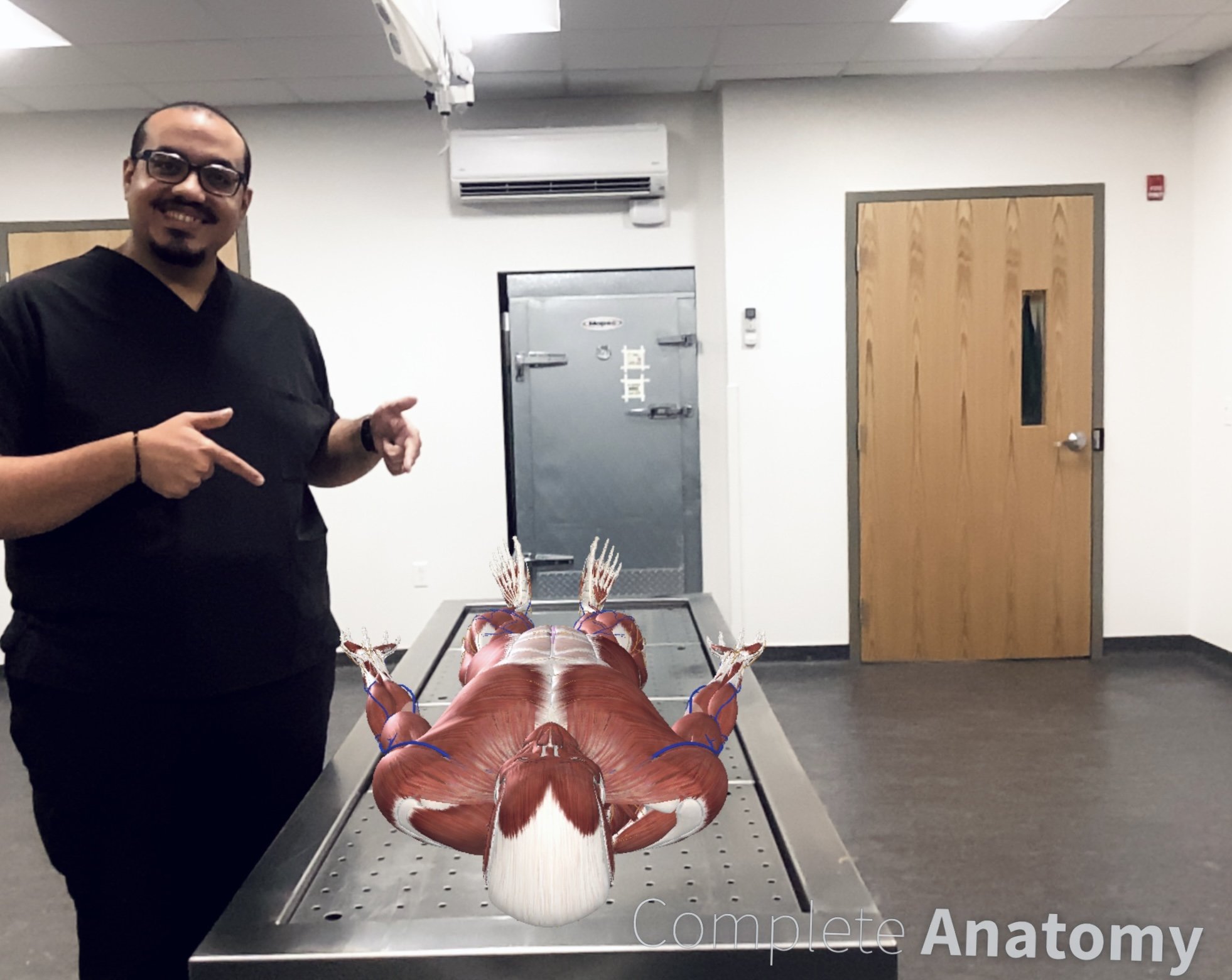Students Get Hands-On and Beyond with Augmented Reality Cadaver Lab
Dr. Sergani posing with an augmented reality cadaver in the human cadaver lab at Chatham Eastside. Photo by Chelsie Corso, MPAS ‘24.
When Dr. Ahmed El Sergani came to Chatham two years ago, he knew he wanted to be at a university that centers teaching, one that places value on a professor’s work with students to implement hands-on, innovative practices that enhance their understanding of the material.
He’s done just that. This semester, students in his Clinical Applications of Basic Sciences course have been using augmented reality to enhance their experience in Chatham’s human cadaver lab. While a class in the human cadaver lab already comes with essential hands-on experience, Dr. Sergani's approach takes it one step further.
Students now have the ability to both work on the physical human cadavers and use an augmented reality program to examine the human body in depth. Augmented human cadavers are displayed on the student's devices, and they then follow along with the instructor's cadaver on a larger screen in the lab. There, Dr. Sergani can move the augmented cadaver around and highlight the structures he is discussing with students more easily and efficiently than with the physical human cadavers.
What is the human cadaver lab?
The human cadaver lab is an anatomy lab space at Chatham University’s Eastside location where students examine human cadavers, bodies of those who have dedicated their deceased remains to science. According to Dr. Sergani, "A cadaver lab is an essential part of anatomy education. Students learn how all the structures of the human body come together. It serves as an opportunity for students who are getting hands-on with the human body in their profession to gain a deep understanding of what they're working with."
"I wanted to enhance the student experiences in the cadaver lab," said Dr. Sergani. "I really, really love to implement technology into my teaching. In today's AR and VR world, it's accessible and worthwhile."
Augmented reality helps fill in the gaps where the physical human cadavers fall short in the learning process. Human cadavers, while useful, don't always arrive at the lab in perfect condition. They don't perfectly reflect how a living-breathing human body functions.
According to Dr. Sergani, using both physical and augmented cadavers is essential for connecting what a student learns about the human body in an anatomy class to what a student may encounter in the workplace.
“This tool shows an idealized rendering of what these structures should look like. It helps the students bridge together what they're learning in a textbook, what the structures look like as a cadaver, and how the structures may appear on a patient,” says Sergani.
This new tool also helps expand the capability of the human cadaver lab. Whereas before, students could only get hands-on experience with cadavers while in the lab, they are now able to access the technology from their own devices to study wherever they are. While on-the-go dissection doesn't sound pleasant, it is a unique opportunity for Chatham students to deepen their understanding and excel in their fields.
“These students are preparing to be professionals. Whether they’re PTs, OTs, or PAs, they truly need to understand the human body. The augmented reality is augmenting their learning experience, beyond the hands-on experience they already get in the cadaver lab.”
Who uses the cadaver lab?
Any student who takes an anatomy course. This includes students in the following programs:
Bachelor of Biology (BA/BS)
Doctor of Occupational Therapy-entry level (ELOTD)
In the case of Dr. Sergani's course, it's an essential part of the learning process for physician assistant studies students. They take his course during their didactic year— the first year of the program spent in the classroom that prepares students for their clinical rotations in their second year. The didactic year heavily focuses on problem-based learning in which students "solve" (diagnose and provide patient education and treatment recommendations) patient cases. Understanding and working with the human body is essential in this process.
It's not only physician assistant students who will benefit from this development, but all students in the cadaver lab. While this is only the first semester that AR has been implemented, there are plans for it to remain for future courses and possibly expand into other lab spaces. It's good news not only for students who use the space, but also for professors like Dr. Sergani who have dedicated themselves to innovative teaching.
"I love teaching. Being at a teaching-oriented university, like Chatham, with small classes means that the university really prioritizes projects like this that enhance learning technologies and experiences. It's truly learner-focused."
Chelsie Corso, MPAS ‘24 demonstrates how the augmented reality cadavers look within the physical lab space
With innovative technologies, hands-on experiences, and professors who care, our health science students graduate prepared to excel in their medical fields. You can learn more about our dynamic programs in the School of Health Sciences here.
Abigail Kneuss is a 2022 graduate of Chatham's Communications and Marketing programs. During her time at Chatham, she enjoyed serving as the Editor-in-Chief of The Minor Bird, Chatham's undergraduate literary magazine, and writing for Chatham's publications. She now works in the higher education industry and is pursuing her Master of Arts in Media Communication and Journalism. When she's not writing or studying, Abigail enjoys reading, hammocking, long walks with friends, and spending time with her five older siblings and seven unruly nieces and nephews. You can find more of her works at bit.ly/kneussportfolio.


